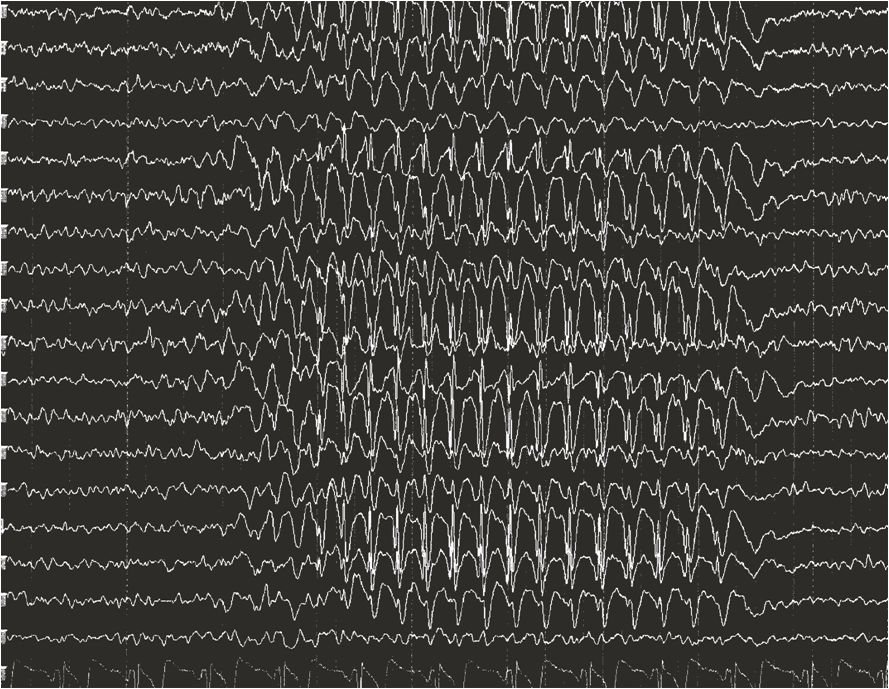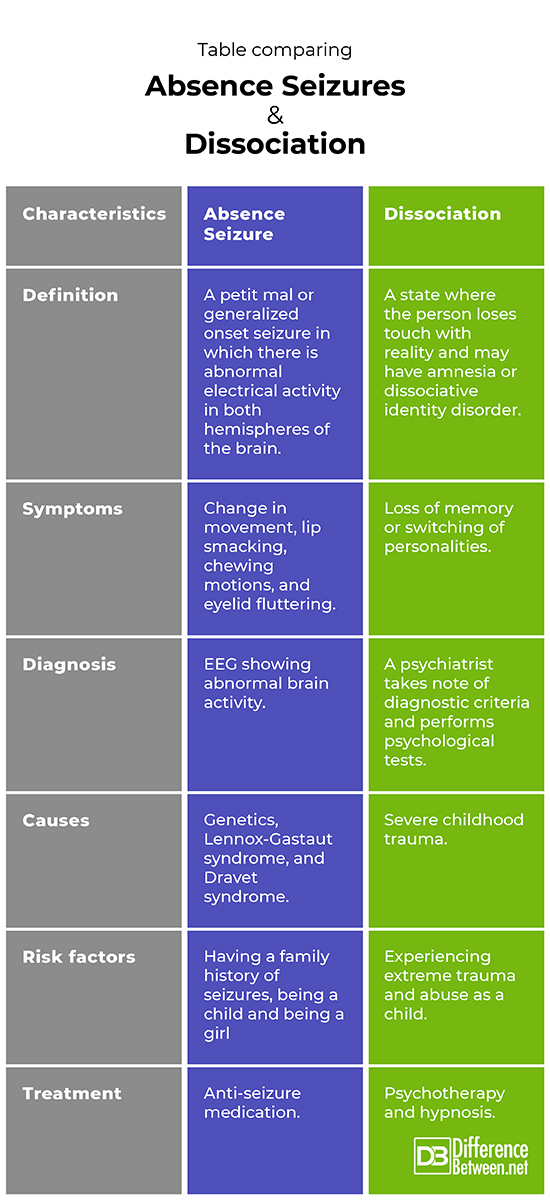Difference Between Absence Seizures and Dissociation
An absence seizure is abnormal electrical impulses in the brain that occurs in both hemispheres. Dissociation is a condition in which a person dissociates or loses touch with reality.

What is Absence Seizures?
Definition:
An absence seizure is a type of seizure also called a petit mal or generalized onset seizure in which there is abnormal electrical activity in both hemispheres of the brain.
Symptoms:
Absence seizures occur most often in children in which there are symptoms such as a lack of movement, lip smacking, chewing motions. Sometimes the eyelids may flutter and the person seems unaware of what is happening and may appear to stare straight in front of them. The seizure lasts between 10 and 20 seconds.
Diagnosis:
The diagnosis of absence seizures is done by ruling out other problems using blood tests, CT scans and lumbar puncture, and then completing an electroencephalogram (EEG). The EEG can detect abnormal brain activity, which is a sign of seizures.
Causes:
Genetic changes leading to unusual activity in the cortex and thalamus of the brain are thought to possibly be responsible for absence seizures, which occur most often in children between the ages of 4 and 14 years, and also more commonly in girls. In some cases, an atypical form of absence seizure occurs in children who have Lennox-Gastaut syndrome and Dravet syndrome, two forms of epilepsy. The Dravet syndrome is the rarer type of epilepsy that is sometimes drug-resistant and thus, difficult to treat but new medications are being developed for reducing the frequency of seizures.
Risk factors:
Children with family members who have seizures are at higher risk for the occurrence of absence seizures. These seizures are also more common in girls than boys. Certain gene mutations have been discovered that increase the risk for some of the types of epilepsy. For instance, Dravet syndrome is associated with the mutation of the SCN1A gene. In other cases, mutated genes that control calcium channels of the nerve cells have been implicated in petit mal seizures.
Treatment:
The treatment involves taking anti-seizure medication to stop the seizures from occurring. Patients with seizures need to take the anti-seizure medications for the rest of their lives.

What is Dissociation?
Definition:
Dissociation includes disorders of the mind where people lose touch with reality. There are different types of dissociative disorders including dissociative amnesia in which a person loses their memory and personal information. Dissociative identity disorder is when a person has multiple personalities.
Symptoms:
People with dissociative identity disorder have two or more separate personalities and they often can’t remember everyday happenings and personal information. They may suddenly dramatically switch personalities, which may or may not be obvious to people who know them, and they are usually not aware of the change themselves. In the case of dissociative amnesia, individuals lose their memory about specific events or even lose their memory about who they are and what their life has been like.
Diagnosis:
Diagnosis involves excluding other conditions using blood tests, EEG, and MRI. Psychiatrists take note of the symptoms, give psychological tests, and evaluate if the patient matches the criteria for dissociation.
Causes:
Traumatic events are the cause of most cases of dissociation. Severe sexual, physical, and emotional abuse during early childhood often leads to dissociation developing in childhood when the identity of the person is being formed.
Risk factors:
People who suffered severe abuse, physical, sexual, and emotional during childhood have the greatest risk of developing some type of dissociative disorder as a protective defensive mechanism.
Treatment:
Psychotherapy and sometimes hypnosis can be used in the case of amnesia to recover memories and in the case of dissociative identity disorder in order to integrate the different personalities into one.
Difference between Absence seizures and Dissociation?
Definition
An absence seizure is a generalized onset seizure in which there is abnormal electrical activity in both hemispheres of the brain. Dissociation is when a person loses touch with reality and may have amnesia or dissociative identity disorder.
Symptoms
Symptoms of an absence seizure include a change in movement, lip smacking, chewing motions, and eyelid fluttering. Symptoms of dissociation include a loss of memory or a switching of personalities but the person is unaware of this change in personality.
Diagnosis
An absence seizure is diagnosed by doing an EEG, which shows abnormal brain activity. Dissociation is diagnosed by a psychiatrist noting diagnostic criteria and performing psychological tests.
Causes
The cause of absence seizures includes genetics, Lennox-Gastaut syndrome, and Dravet syndrome. The cause of dissociation is severe childhood abuse and trauma.
Risk factors
Children, particularly girls, are most at risk of absence seizures and if there is a family history of seizures. People who have experienced severe abuse in childhood are most at risk of dissociation disorder.
Treatment
Anti-seizure medication is used in the treatment of absence seizure. Psychotherapy and hypnosis are used for treating people who have dissociation disorder.
Table comparing Absence seizures and Dissociation

Summary of Absence seizures Vs. Dissociation
- Absence seizures are due to problems with electrical impulses in the brain that are often caused by genetic problems.
- Dissociation is a condition that happens because of extreme childhood abuse and trauma.
- Absence seizures are treated with anti-seizure medications.
- Dissociation is treated with psychotherapy and hypnosis.
- Difference Between Rumination and Regurgitation - June 13, 2024
- Difference Between Pyelectasis and Hydronephrosis - June 4, 2024
- Difference Between Cellulitis and Erysipelas - June 1, 2024
Search DifferenceBetween.net :
Leave a Response
References :
[0]Adamolekun, Bola. “Seizure disorders”. Merck Manual, 2018, https://www.merckmanuals.com/professional/neurologic-disorders/seizure-disorders/seizure-disorders
[1]Avoli, Massimo. "A brief history on the oscillating roles of thalamus and cortex in absence seizures." Epilepsia 53.5 (2012): 779-789.
[2]Mayo Clinic. “Dissociative disorders”. Mayo Clinic, 2021, https://www.mayoclinic.org/diseases-conditions/dissociative-disorders/symptoms-causes/syc-20355215
[3]Image credit: https://live.staticflickr.com/1693/24897515506_6f06b5c5a9_c.jpg
[4]Image credit: https://upload.wikimedia.org/wikipedia/commons/7/74/EEG_Absence_seizure.png
